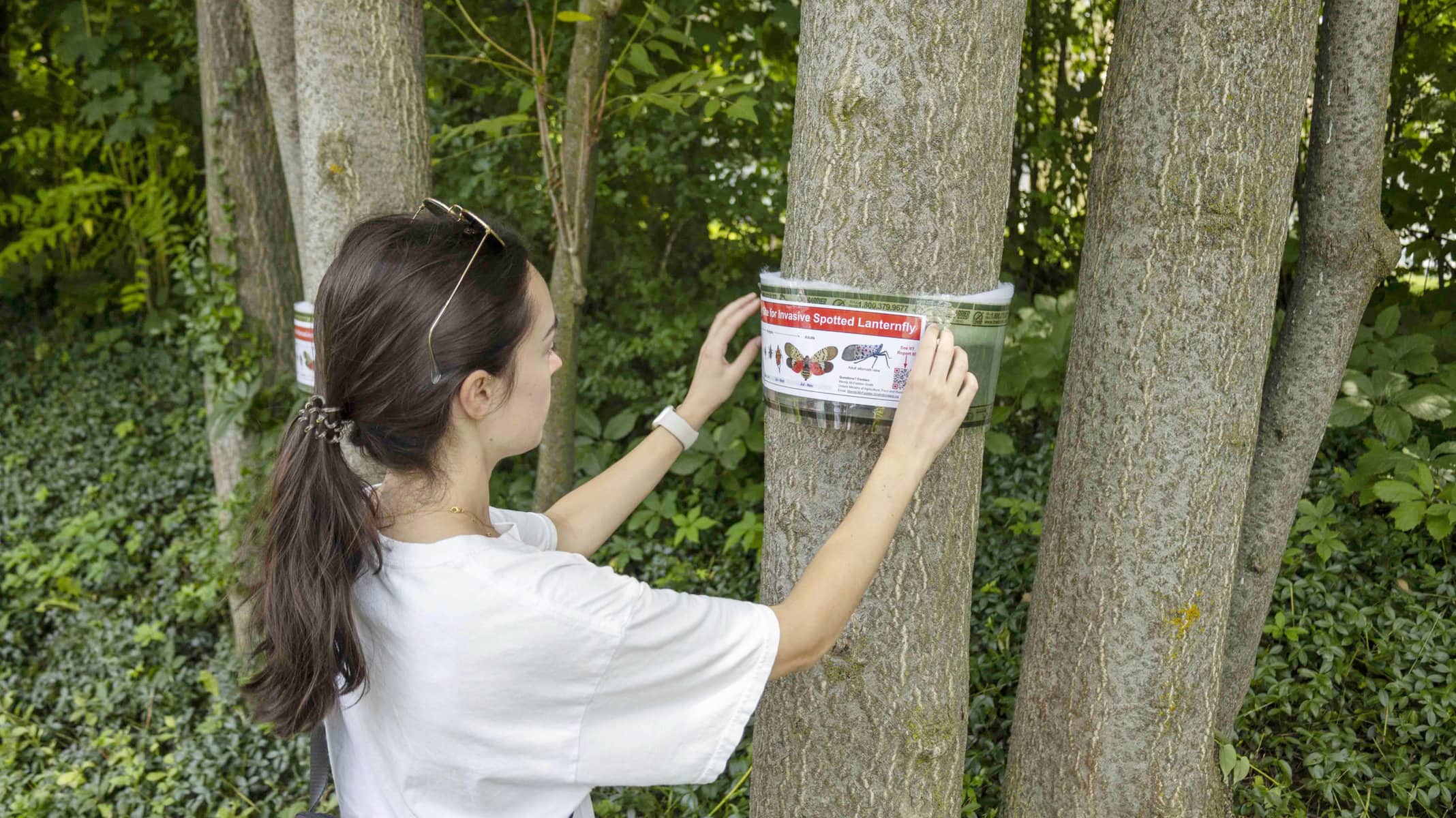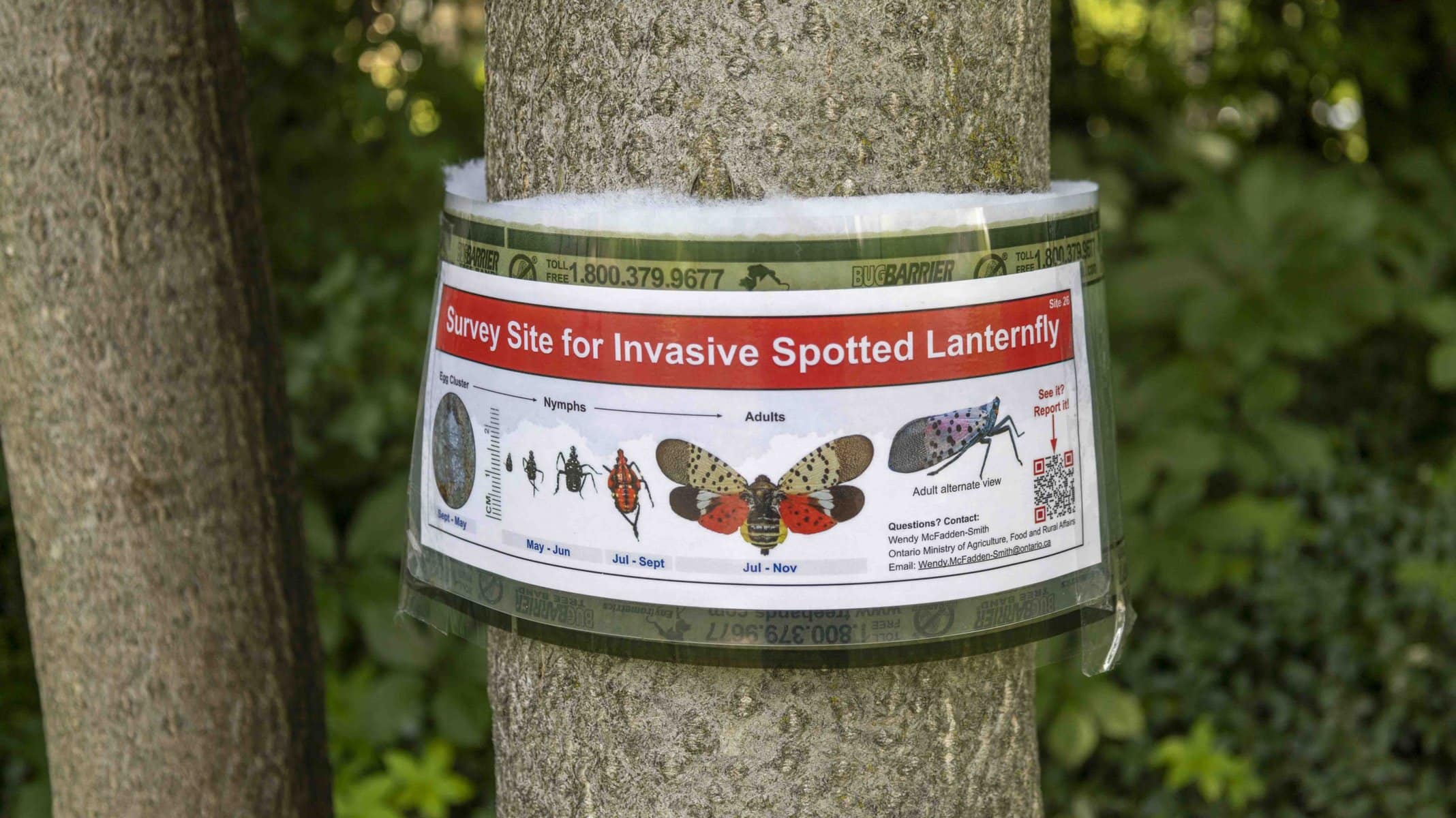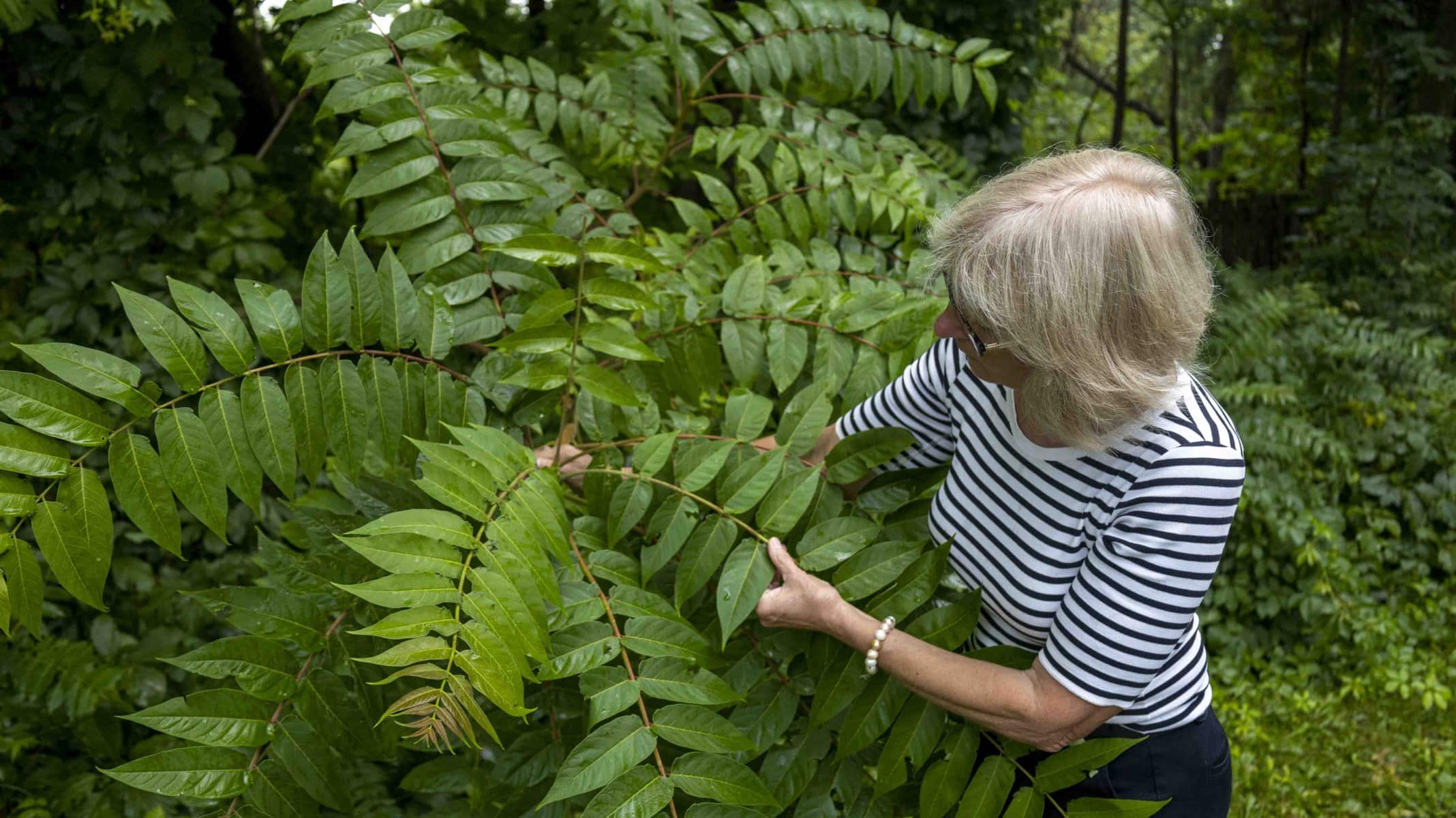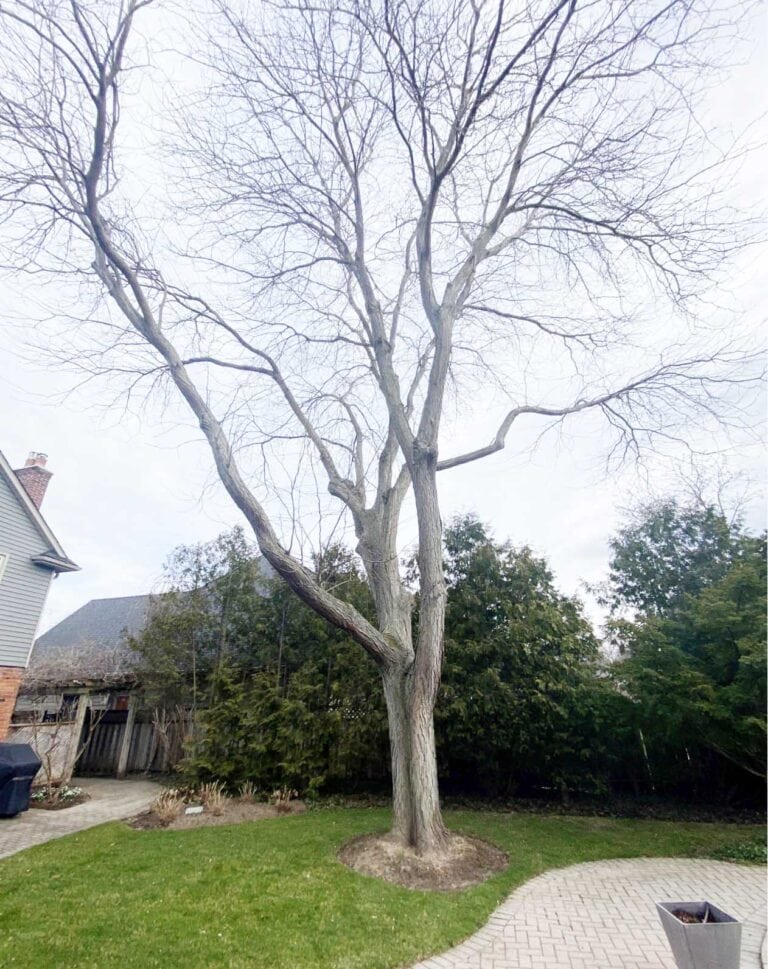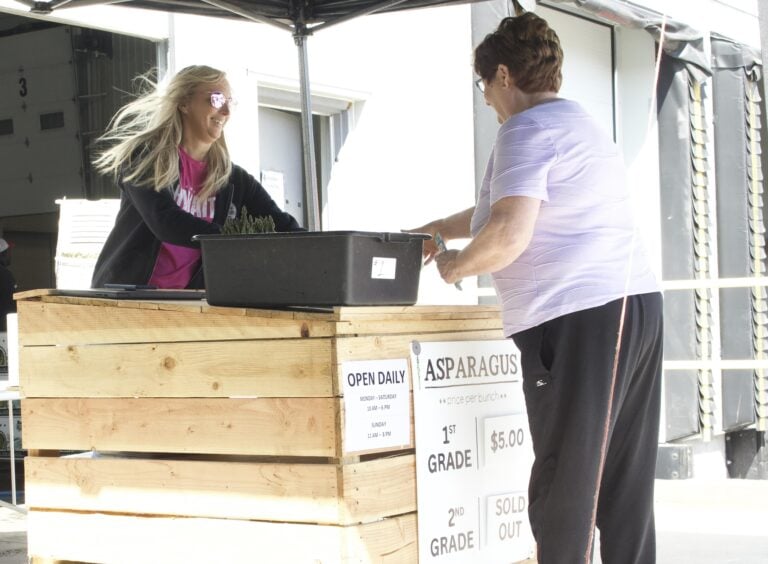Spotted lanternfly traps are showing up on trees around Niagara-on-the-Lake, in an effort to spot the invasive bug before it spreads.
The highly invasive species hasn’t been found alive yet in Canada, but experts are saying it’s a matter of when it arrives, not if — and warding off its invasion.
The Ontario Ministry of Agriculture, Food and Rural Affairs is responsible for setting up the traps in collaboration with multiple government bodies.
There are about 40 traps set up around the Niagara region and about 16 across town.
“The whole idea of the traps is just to identify where (the spotted lanternfly) is located and try to limit its spread from there,” said Wendy McFadden-Smith, a pest management specialist with the ministry.
Last year, the spotted lanternfly was discovered at the Buffalo border, where it has since turned into an infestation.
The insect, originally from China, is recognizable thanks to its namesake – an adult measures about 25 millimetres in length, with a black head and gray-brown forewings with black spots.
It has the potential to wipe out entire vineyards – as it’s done in parts of the United States.
As the spotted lanternfly climbs the tree, it’ll hit the batting that’s wrapped around the tree, fall back and land in the sticky trap.
The agriculture ministry distributes these traps across many parts of Ontario. There’s also information on each trap for residents to read and a QR code that can be scanned for more information.
While spotted lanternflies prefer the tree of heaven – an invasive exotic plant from Asia brought to North America in the 1700s – as their host tree, they also love to feast on grape vines and black walnut trees.
“Even though they really like the tree of heaven, they don’t need it to complete their life cycle,” said Emily Posteraro from the Invasive Species Centre.
The insect is not picky: it likes to feed on more than 100 different plants and trees, using its piercing teeth to suck its hosts dry of sap.
They destroyed vineyards in Pennsylvania – some vineyards have lost up to 50 per cent of their vines due to infestations.
Rather than setting up traps only according to tree species, however, McFadden-Smith said the agriculture ministry has set up traps in areas that would see a high volume of vehicle traffic.
“Because it’s a hitchhiking species, we’re trying to identify places where cars or trains or trucks would park that are coming from the States,” she said.
She said she went around with Kevin Turcotte, the town’s manager of parks and recreation, and found suitable trees for the trap.
Niagara-on-the-Lake is littered with the tree of heaven: one can see several of them populating the start of the Heritage Trail at John and King streets.
In an email to The Lake Report, town spokesperson Marah Minor said staff visited the location last week and identified 17 trees in the area.
The town currently doesn’t have an invasive species management plan, said Minor, but one is in the works – which includes taking an inventory of how many trees of heaven are in town and implementing a response plan.
She noted that on July 25, council approved its 2022 to 2027 strategic plan, which included a section called “Enrich Community Assets, Environment & Infrastructure, one action item is to develop an Invasive Species Plan.”
Minor also provided a link to the town’s website where more information on invasive species can be found, at notl.com/town-services/environmental-stewardship/invasive-species.
Master gardener Betty Knight compared the potential invasion of the spotted lanternfly to the “apocalypse” and said the arrival could be detrimental to Niagara’s agricultural industry.
Knight has been helping the group Save Our Pollinators make a pollinator garden with native plants along the Heritage Trail.
However, it’s a difficult task since there are so many invasive species fighting for the spotlight.
She said the group has brought the tree of heaven to the attention of the town many times.
“The tree of heaven needs to be removed and they (the town) know it needs to be removed,” said Knight.
The tree produces more than 300,000 seeds annually and has a high germination rate.
Besides being a favourite for the spotted lanternfly, this invasive plant can choke out native plants and alter the surrounding plant community and prevent the growth of other plants.
It can also cause infrastructure problems and affect human health.
It reproduces colonially, said Posteraro, so there’s a good chance all of the new trees sprouting at the Heritage Trail started from one tree.
Posteraro also noted that because the spotted lanternfly will feed on anything, removing it might not stop the introduction of the invasive insect.
While the spotted lanternfly has been a federally regulated invasive species since 2018 due to its threat to grape, fruit tree and forestry industries, the tree of heaven is not regulated.
In an email to The Lake Report, Marcela Mayo, corporate communications officer for the Ministry of Natural Resources and Forestry, said that this means the town is not obligated to remove the trees.
The natural resources ministry is in charge of implementing Ontario’s Invasive Species Strategic Plan (2012), and administers the Invasive Species Act.
Since the tree of heaven is not regulated, there’s no law stopping people from purchasing or planting it.
According to a report released by the Office of the Auditor General of Ontario at the end of 2022 regarding the management of invasive species, the tree of heaven – along with 29 other species – should be considered for regulation under the Invasive Species Act.
Since it is all across Canada, a spokesperson from the Canadian Food Inspection Agency said regulating it would not be effective.
Mayo wrote that the ministry prioritizes invasive species for “regulatory consideration” based on the results of ecological risk assessments and assessments of potential socio-economic impacts.
Such assessments have been conducted for the tree of heaven, and will help decide the next steps, Mayo wrote.
Posteraro noted that the tree is incredibly difficult to remove and someone would normally need a licensed pesticide applicator to properly get rid of it.
Knight said now is the best time to remove the trees.
“The trees should be taken down now, and a systemic herbicide applied from July until fall colour comes, because that’s when trees are moving carbohydrates into the root system,” she said.
She said after applying the herbicide from now until the fall, the town would need to be on top of it in the spring.
She said she realizes it’s not that easy.
“That takes manpower, and that takes money and we’re a town of tourists. So, you can’t just be spraying herbicides,” she said.
Postero said if people can remove them they should, but if it’s not feasible, then people should report it and monitor the tree.
“That might be able to tell us where a spotted lantern fly could establish if and when it gets here,” she said.
Tree of heaven or spotted lanternfly sightings can be reported to Eddmaps.org, Inaturalist.org or by sending an email to info@invasivespeciescentre.ca.



